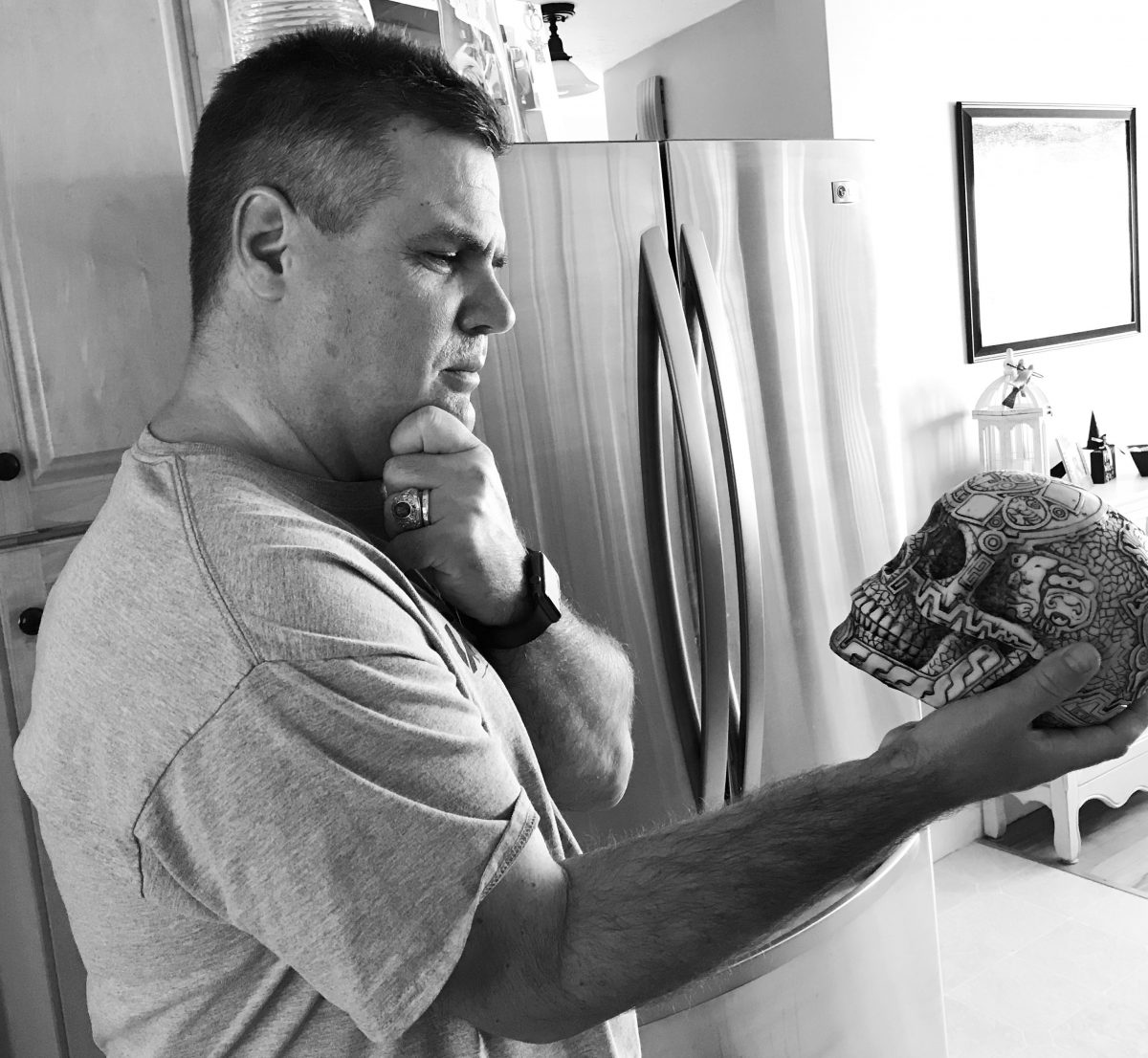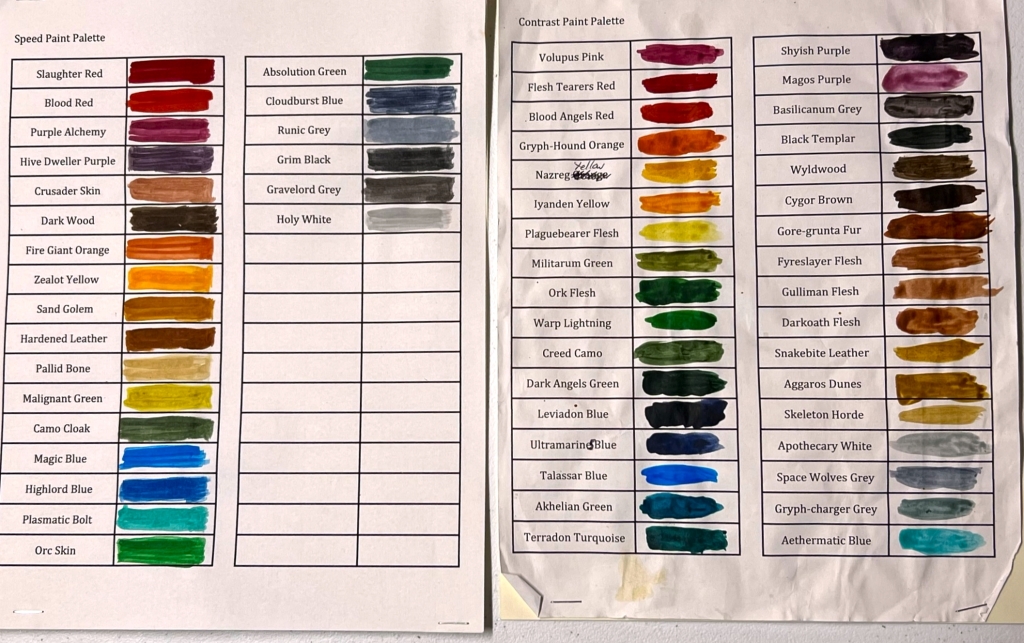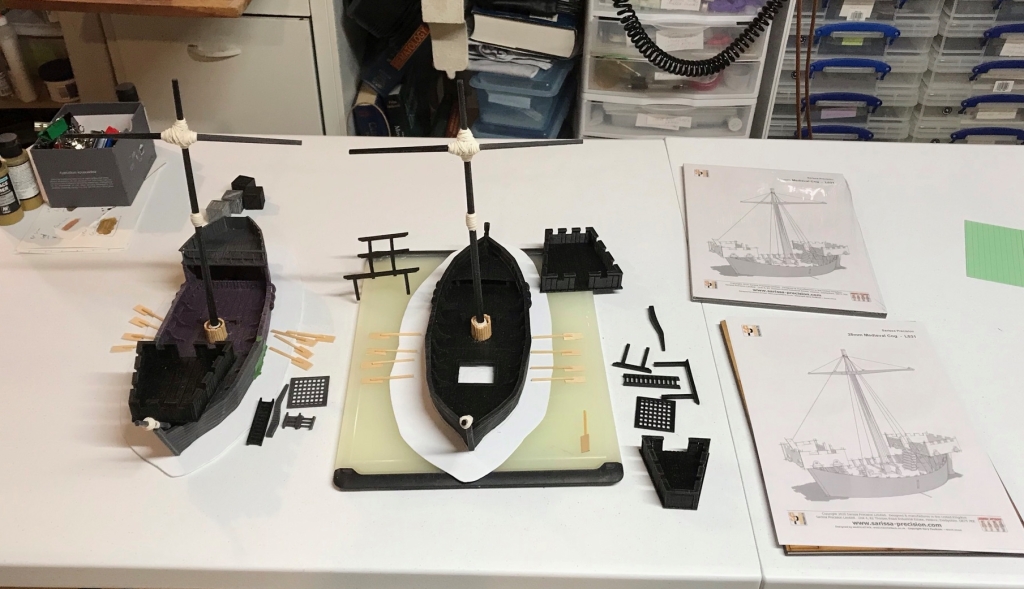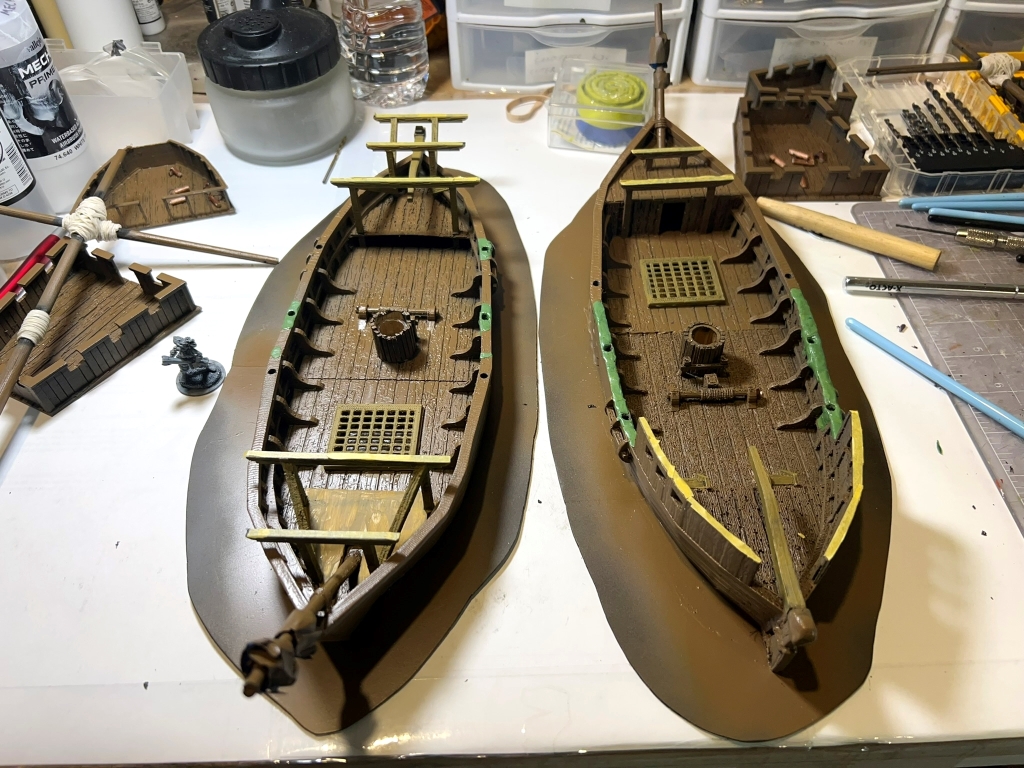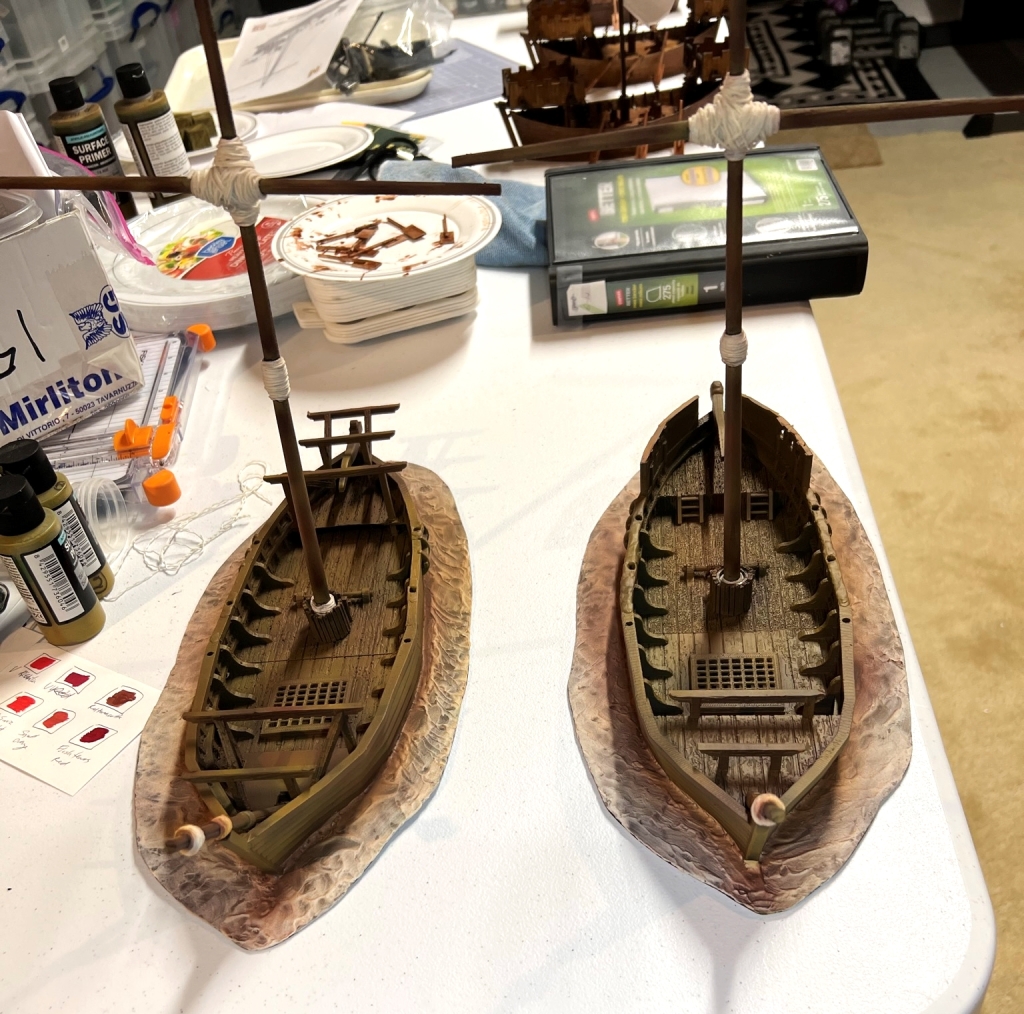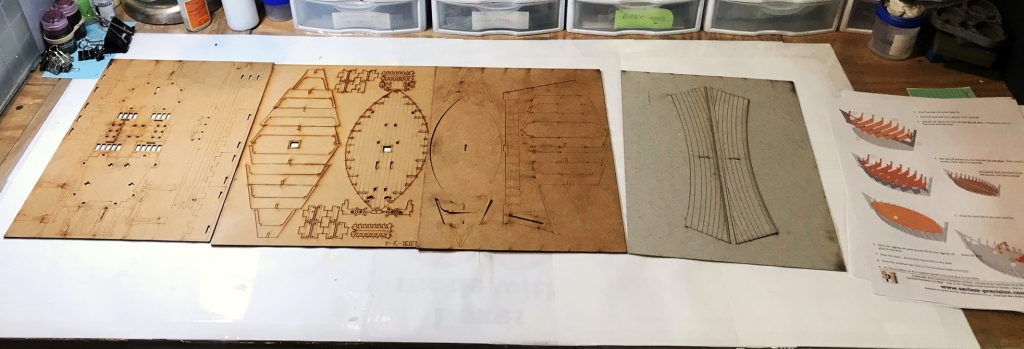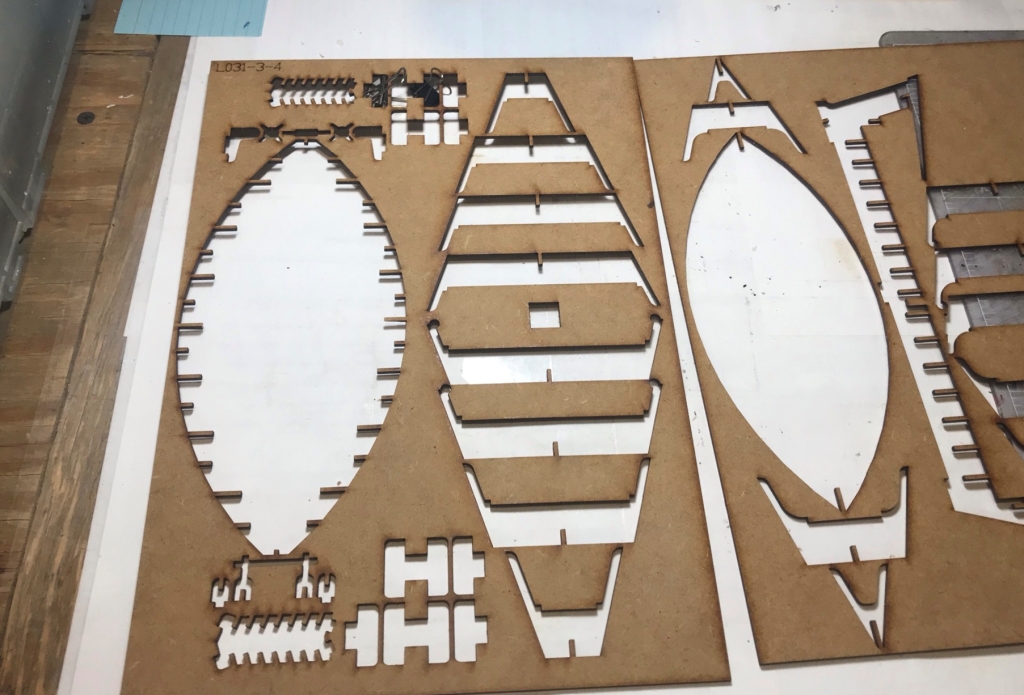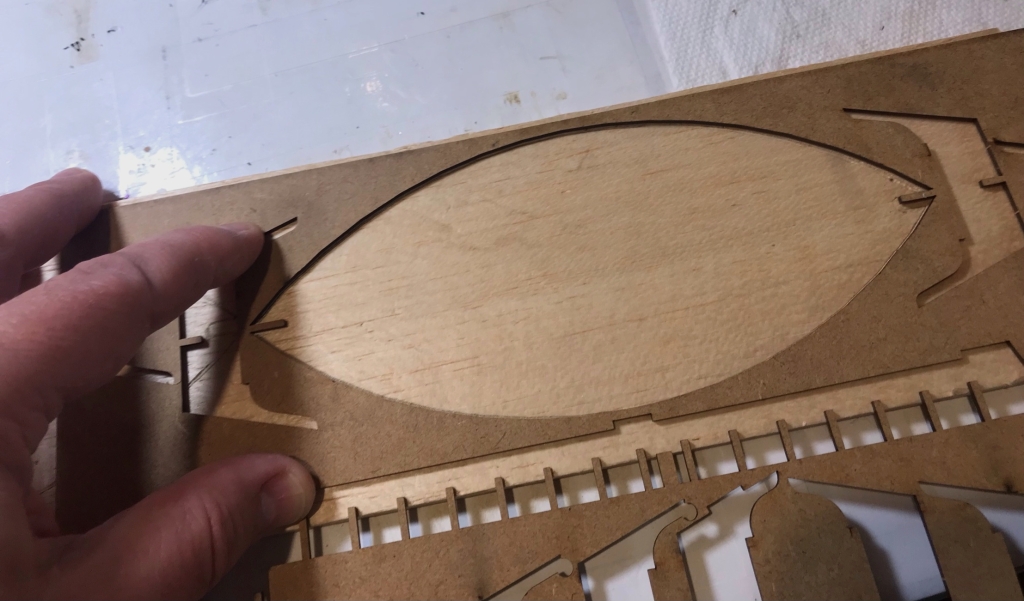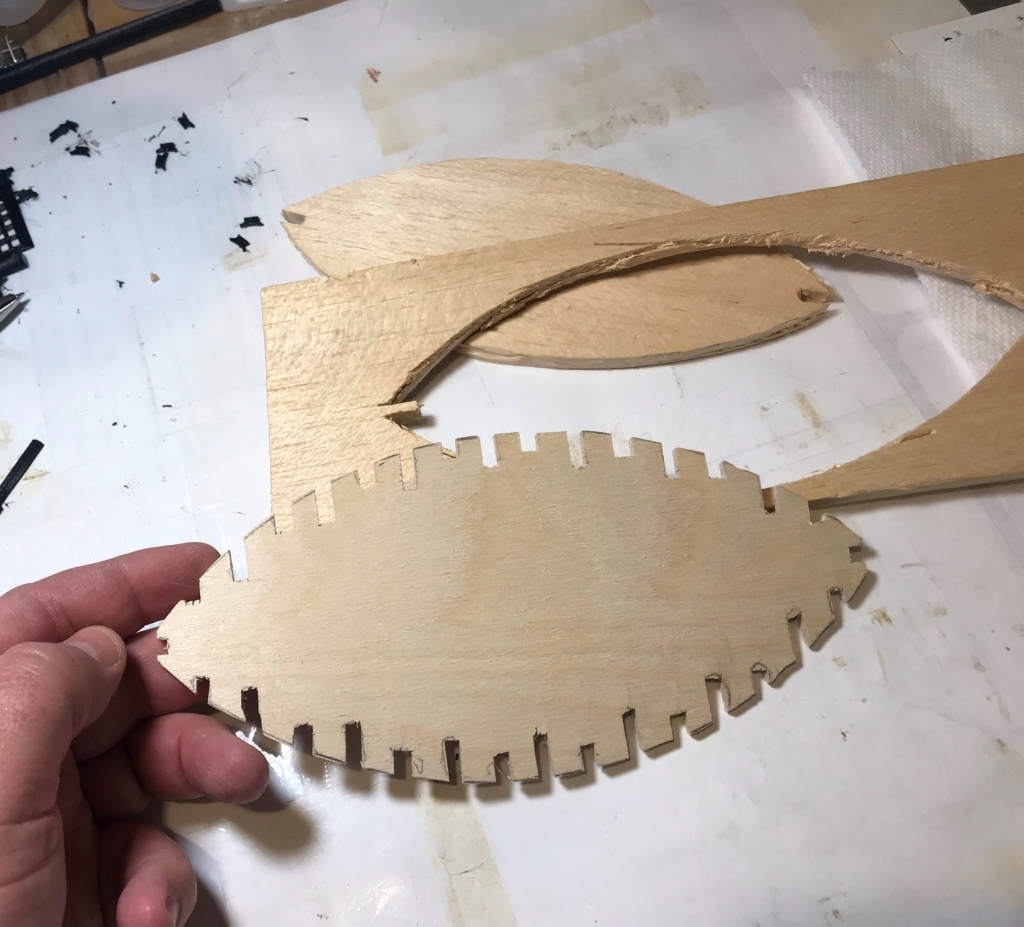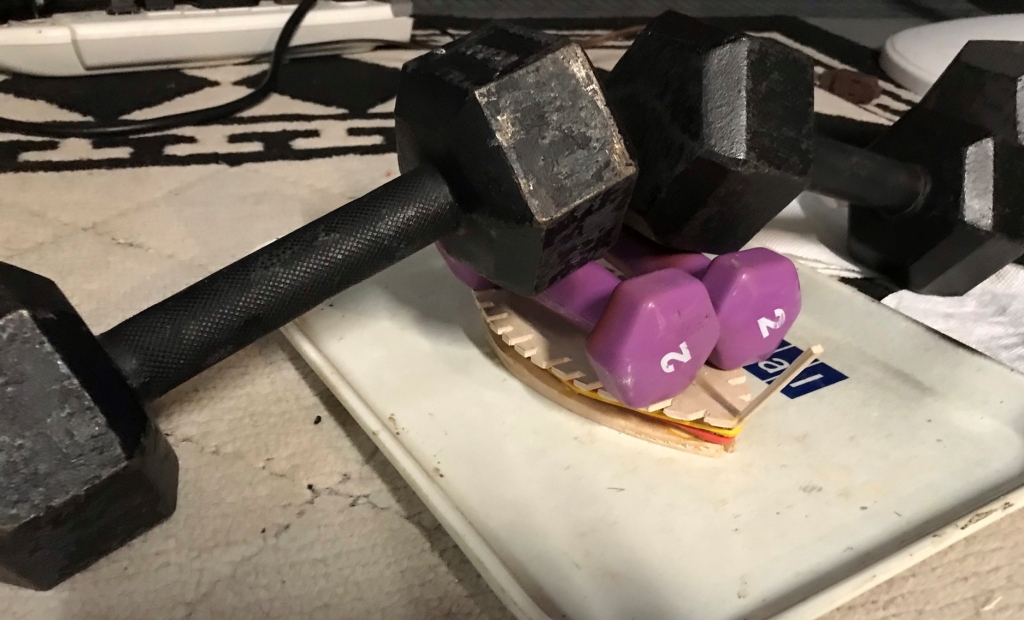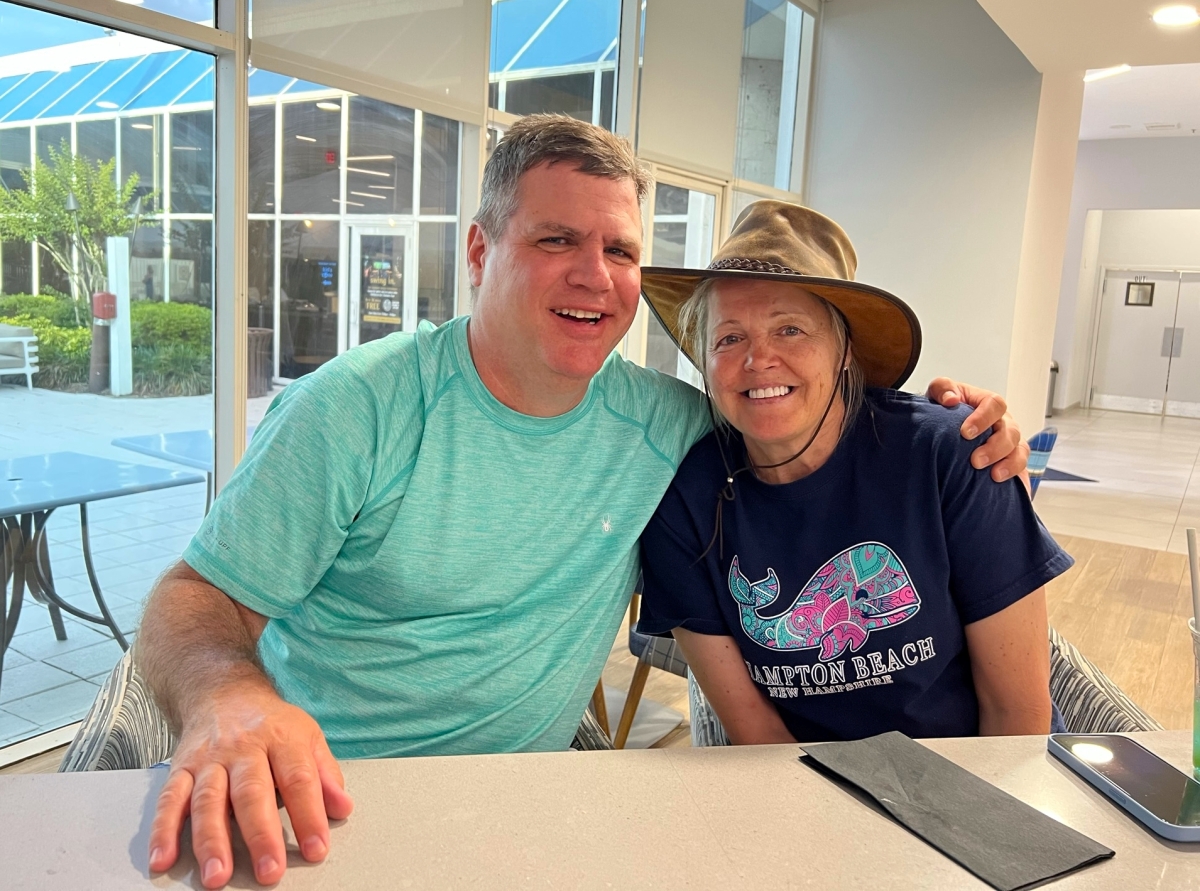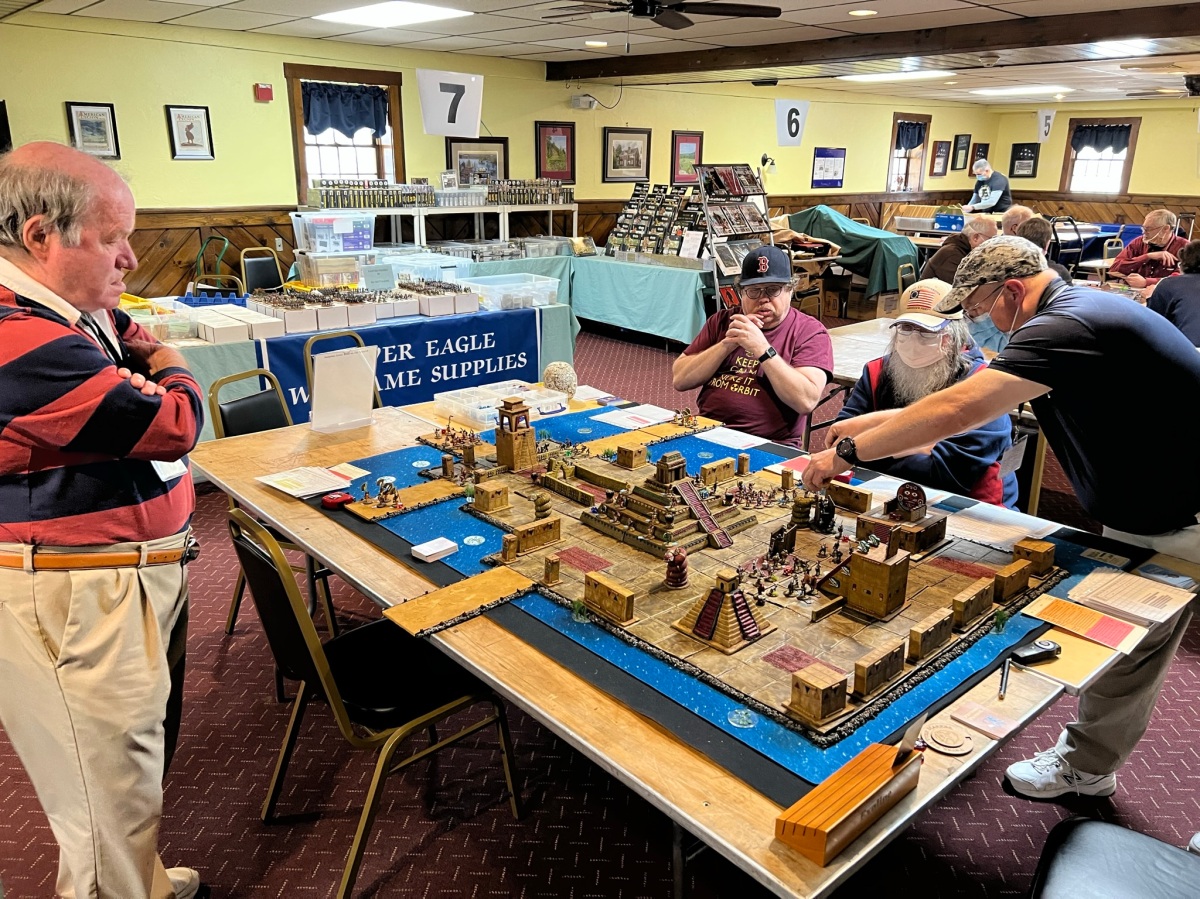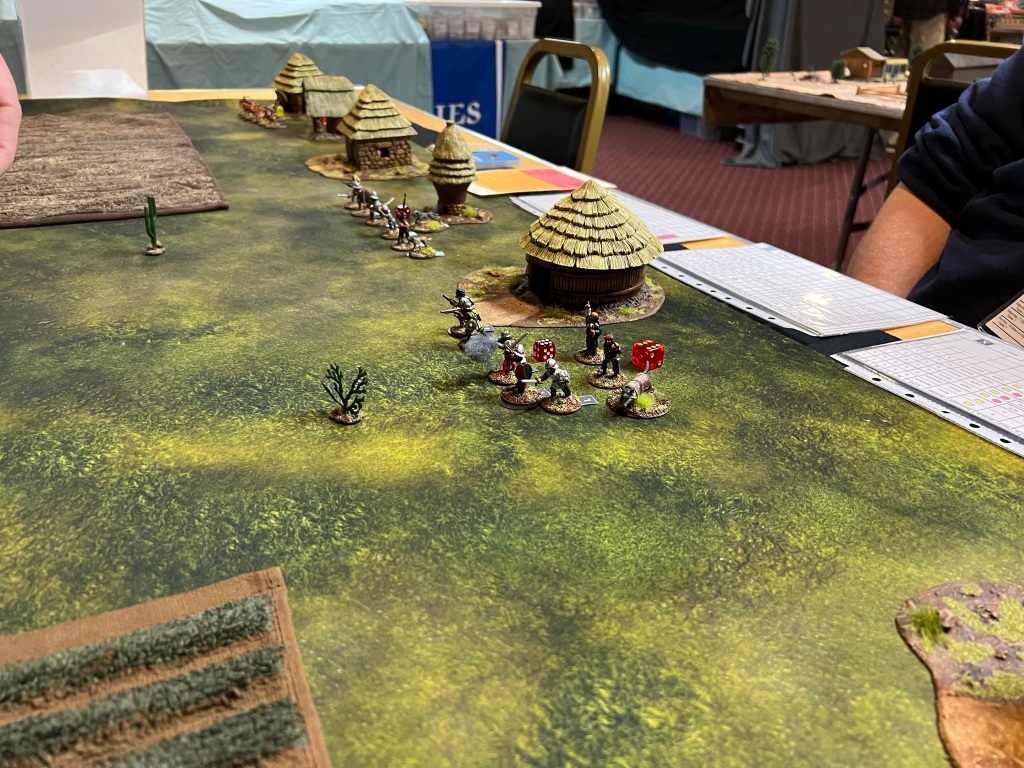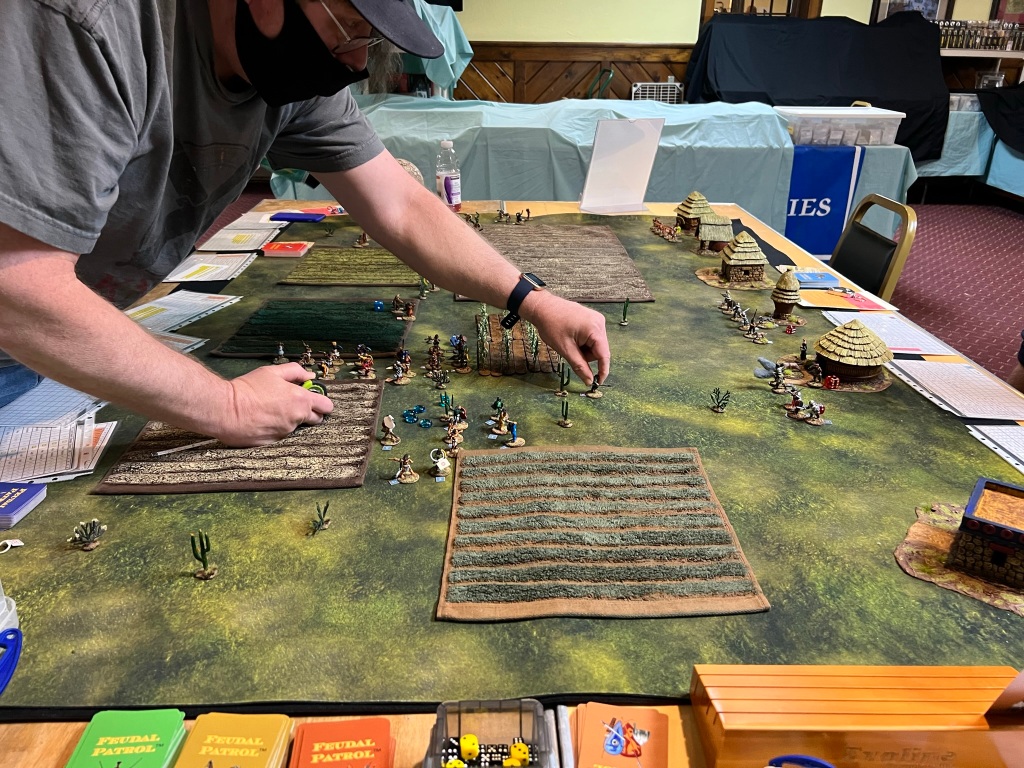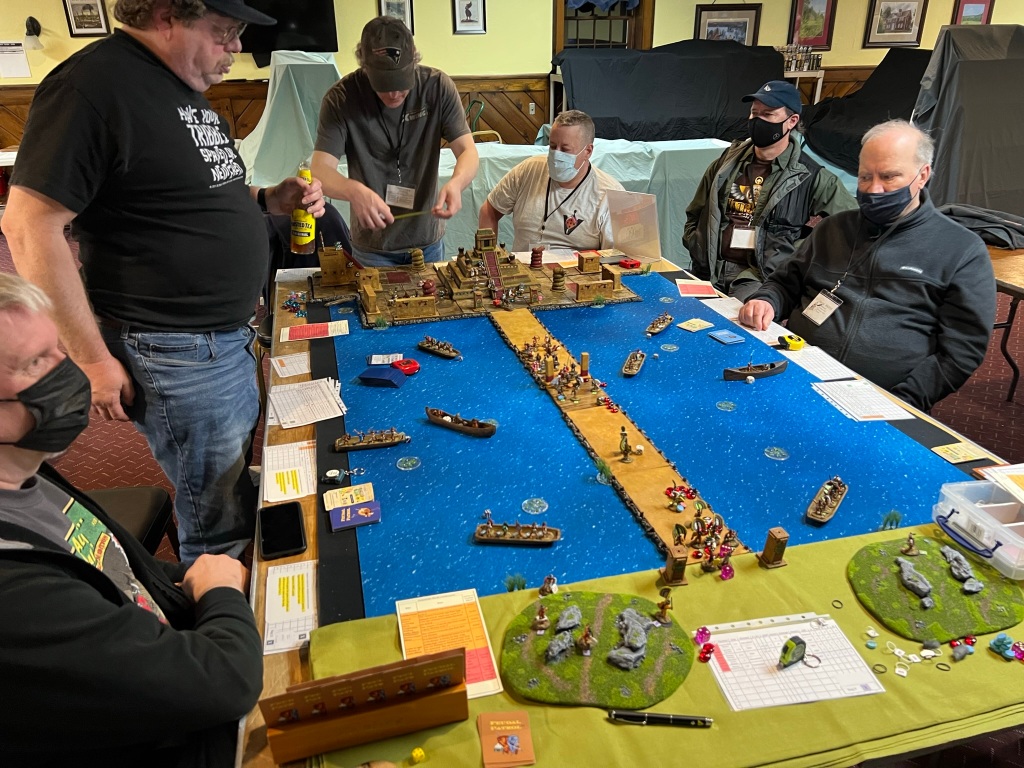HUZZAH! 2022 was held in South Portland Maine from Thursday May 12th to Sunday May 15th. This would mark the first time that this great convention ran since the beginning of the pandemic.
I had previously attended HUZZAH! as only a gamer in 2019 and blogged about it here. I was impressed with the games there and as well with the Maine Historical Wargamers Association (MHWA) that runs it. I was determined that I would run some games there in 2020….
That became 2021…
And that became 2022 – which was the return of HUZZAH! By this time I had a LOT of games that I had build for Mesoamerica and the Spanish Conquest. There were 8 four-hour game slots available at the convention – one on Thursday evening, three on Friday and Saturday, and one on Sunday morning. Of course – I had just ran 4 four-hour games at HAVOC in Massachusetts in April. So, I thought, why not push myself and run 6 Feudal PatrolTM games in four days? Hell, it would be fun my using my supplement for Civilizations Collide for so many games to a brand new audience.
That’s 6 out of the 8 available four-hour slots! That’s 24 hours of GM’ing in about 60 hours…not counting set up and take down. Well, I gave it a shot, and while as I write this it’s late June, I thought I’d share some pics with you folks as it was a BLAST! I’ll take each game in turn.
Besides, you all DID ask for game pics – buckle up, there’s a bunch here!
Thursday Evening, “Cortes’ Causeway Escape Attempt”
The first game scenario that I ran was “Cortes’ Causeway Escape Attempt”. This involves the Spanish trying to escape Tenochtitlan on June 28, 1520. For those who have not seen my HAVOC posts on the scenario – here is the game briefing:
While Cortes was away confronting Narvaez at the Battle of Cempoala, some of his troops under the command of Pedro de Alvarado had remained in Tenochtitlan. Cortes had previously bloodlessly seized Montezuma as his prisoner/puppet, so he felt relatively secure to make the trek to Cempoala. This was not the case with Alvarado. He feared that the Aztecs were planning to surprise his troops and massacre them; thus, he decided to strike first. At the Feast of Toxcatl (an annual Aztec religious festival), hundreds of the political and military elite of the Aztec Empire were participating in the “Serpent Dance” – and were unarmed. Alvarado took the chance and attacked all of those celebrating with no quarter. Most were murdered and some were captured. The warriors killed by Alvarado and his men were among the best in the Aztec Empire. Still, the Spanish and their Tlaxcalan allies were far outnumbered in Tenochtitlan, and they now faced an entire city that was rising up against them. Cortes returned from the Battle of Cempoala. His forces were reinforced by the men and equipment of Narvaez who had defected to Cortes’ banner. He was able to enter Tenochtitlan with his men, and soon learned of the general uprising. As a goodwill gesture, yet a strategic mistake, he released Montezuma’s brother, Cuitlahuac – who had been captured by Alvarado at the massacre. Cuitlahuac almost immediately became the leader of the Aztecs, effectively becoming the new Emperor – and Montezuma’s replacement. The siege of the Spanish began in earnest. The Spanish had occupied the Palace of Axayacatl, were without water, and were coming under increasing attack. The Aztecs even tried to burn the palace down around the Spanish, but were stopped with artillery, crossbow, and arquebusier fire. Cortes tried to use Montezuma one last time – to see if the Aztecs surrounding them would stand down. Montezuma was brought out at the Palace of Axayacatl try to get the attackers to stop their assault. Montezuma’s exhortations not only failed to sway the crowd of enraged Aztecs, but he was hit in the head by a rock from an Aztec sling. That wound would incapacitate him. Shortly afterwards, he died. The cause of his death was the slung stone or perhaps he was murdered later by the Spanish as he lay unconscious – the truth is forever lost to history. In the end, Cortes realized that he had no safe escape route to the causeways. In any such attempt, his troops would be vulnerable to a massive volume of missile fire. Cortes ordered his men to tear out any lumber available from the palace to build a number of war wagons. These would serve as similar devices to the Hussite war wagons of the 15th Century, but would be moved by humans, not horses. Cortes hoped that they would hopefully provide cover for his own missile troops from withering Aztec missile fire – and therefore help his forces make it to the causeways. With these war wagons, Cortes launched an escape attempt that he hoped would be able to punch through the Aztecs and escape to the causeways – and then onto the safety of the mainland and the his Tlaxcalan allies.
In the game. the Spanish broke through the Aztecs, though at significant cost. The Aztec commander was taken out by the Tlaxcalans (Conquistador allies). This was effective at reducing the Aztecs command and control, allowing Cortes to live for another day…again. Below are some game pics with a few descriptions.





Friday Morning, “Surprise Aztec Raid on the Spanish Outpost”
On Friday Morning, I had a full table for my “Surprise Aztec Raid on the Spanish Outpost” scenario. I also ran this game at HAVOC and at TOTALCON 2022. Here is the game briefing:
Near harvest time, a Tlaxcalan village is being raided by the Aztecs, seeking to take wealth, food, and prisoners. The Aztecs know the majority of the Tlaxcalan troops are with the Conquistadores elsewhere, and expect an easy task. Unbeknownst to the Aztecs, there are some Spanish troops at this town who will help to defend it. This is a generic scenario based on Aztecs launching a surprise raid Veracruz or a Tlaxcalan Village serving as a supply base for Cortes.
It was a lot of fun and I was honored that the game won the Best in Time slot award which was nice. It was a pretty exciting game with a few twists and turns. In the end, it was an overwhelming Spanish victory (64-6) as the Conquistadores and their Tlaxcalan allies held off the raiding Aztecs.














Friday Night, “La Noche Triste – Bloodbath on the Tacuba Causeway”.
This game was on Friday night, and is one of my favorites. It has war canoes, cavalry, and desperation! I had another full table for the game of “La Noche Triste – Bloodbath on the Tacuba Causeway”. I also ran this game at HAVOC. Here is the game briefing:
The struggle for the high ground of Temple of Yopico had been a fleeting success for Cortes. Importantly, the Spanish had not succeeded in the most important task at hand – allowing Cortes and his troops to escape Tenochtitlan and reach the safety of Tlaxcalan allies on the mainland . While the Spanish did temporarily seize the high ground of the temple, their war wagons were now destroyed, their supplies of food and water were gone, and they found themselves again trapped in the Palace of Axayacatl surrounded by thousands of angry Aztecs. Times were even more desperate. For those trapped in the city, one last try would either succeed or fail. Either way, a Spanish failure meant either death on the battlefield or on the Altar of Huitzilopochtli. Success might still mean death on the battlefield. Cortes knew that the Aztecs had removed multiple spans over the canals on the causeways, which effectively meant that he would have to bridge those gaps to get to the mainland. Cortes’ men stripped beams from the palace, and had constructed pieces to make temporary haulable bridge pieces. No matter which causeway the Spanish took – they faced a dire situation. Cortes decided to try to make a night escape attempt with all of his forces – and head for the Tacuba Causeway – which was the shortest way out of the city. He left at midnight, and under the cover of darkness, made headway undetected – for a while. The Aztecs finally detected the Spanish movements, and raised an alarm. War canoes, manned by Aztec warriors, surrounded Cortes’ troops on both sides of the Tacuba Causeway, and he faced enemies to his front and his rear. Cortes’ men and his Tlaxcalan allies had taken with them as much looted treasure as possible, as well as prisoners (sons and daughters of the now-late Montezuma). The Aztecs are hell-bent on stopping their escape. A Tlaxcalan warband will try to help clear the way to the Spanish from the mainland.
The Spanish fought valiantly but this time Cortes was not successful. The Spanish managed to bridge the causeway gap but the Aztecs would not yield and their war canoes were effective.
Here are some battle shots:







Saturday Morning, “The Battle of Otumba”
On Saturday morning I ran “The Battle of Otumba” scenario, where the conquistadores held out on a rocky hill against a massive Aztec onslaught while hoping that Cortes would arrive in time with the cavalry to save the day. The cavalry arrived, but were ineffective (just damn unlucky) and the Aztecs won an overwhelming victory with the casualties that they inflicted. I also ran this previously at TOTALCON and HAVOC, but with very different results (which I believe speaks to a balanced scenario).
Here is the game briefing:
For almost two weeks, the troops under Cortes retreated across central Mexico – hoping to reach the safety of Tlaxcalan territory. All of the Spanish were wounded to some degree – many died each day from the wounds suffered during La Noche Triste and the subsequent skirmishes that occurred as the Aztecs, under Cuitlahuac, pursued them mercilessly. The Conquistadores found themselves on a small rocky outcropping – and according to Diaz nearly surrounded on two sides. They were just short of the mountain pass that would bring them to safety of Tlaxcala. They took up an infantry square position bristling with pikes and halberds upon on the rocky outcropping overlooking plains. The Aztecs rained missile fire upon the Spanish, and subjected them to numerous human wave attacks. The brutal end was near when Cortes noticed that the attacks were being coordinated by the cihuacoatl, the High Priest of Tenochtitlan, the Cihuacoatl Matlatzincátzin. He was the one who was acting as the Aztec General. This High Priest was using signalers and bannermen to coordinate the attacks. Cortes personally rounded up what remained of his cavalry and with great personal courage led a mounted charge towards the High Priest and his retinue. The Aztecs had never before faced a massed cavalry attack. While the hooves of the Spanish cavalry were previously unable to make such a charge on the smooth pavements of Tenochtitlan – at Otumba, they were able to make a classic cavalry attack. The charge succeeded in killing the High Priest and many of his officers. It was reported that Cortes himself dispatched the High Priest with his lance. With the death of their leader and disruption of his communications system, the Aztec attack faltered. It quickly fell apart without the command and control that the signals had provided. Cortes and what was left of his troops were able to escape to fight another day, and eventually conquer the Aztec Empire – but this battle could have changed the course of history.
Here are pics of the game:









Saturday Night, “The Battle of Lake Texcoco”
As followers of this blog know, I built a fleet of brigantines (well 5) for this game, “The Battle of Lake Texcoco”, which you can read about here and here. I was REALLY excited to roll this out -and I needed a BIG table -which MWHA did accommodate.
Here is the game briefing:
To seize control of the Aztec island capital of Tenochtitlan, Cortes realized that he needed to control the surrounding waters of Lake Texcoco. This meant building a fleet. To accomplish this, Cortes used scavenged lumber from his previously-scuttled seafaring vessels to build brigantines in pieces in Tlaxcala. These prefabricated pieces were then man-portaged by his Tlaxcalan allies to the shore of Lake Texcoco. Here they were assembled, and made ready for combat on the lake. While simultaneously he sent land-based conquistadores to attack Tenochtitlan’s causeways, Cortes launched his brigantines to attack Tenochtitlan. In his way were hundreds of Aztecs canoes waiting to swarm over the Spanish.
I was really thrilled at the response. What fun it was – an Aztec vs. Conquistadores naval game! It was total mayhem! How? Collisions, ramming of canoes, brigantines getting boarded, canoes getting sunk by arquebuses, ship cannons firing and wiping out whole canoe crews, Aztecs avenging their comrades by wiping out the same cannon crew, and the overall Aztec commander personally boarding a conquistador brigantine to make an assault that cost him his life and the game.
WOW!
And I was honored to receive my second Best in Time Slot award of the convention! Not bad for a naval game scenario designed by a West Pointer ![]() !
!
Here are some battle shots:













Sunday Morning, “Raid to Satisfy Huitzilopochtli”
On the final day of the con, I an my 6th (!) Feudal Patrol game in 4 calendar days, “Raid to Satisfy Huitzilopochtli”. This is set pre-Spanish Conquest and simulates a “Flower War” that the Aztecs historically used to seize food, wealth, and people from their unlucky neighbors like the Tlaxcalans. This was the first scenario that I had designed for Civilizations Collide, but I had not run it in a while – so it was nice to see how it played out.
Here is the game briefing:
The Aztecs conduct a raid of a neighboring village to gain captives for slavery and blood sacrifice. The defender may choose to be Aztecs of the Aztec-Chichimec Alliance, Mixtec/Zapotec, or Maya. This is similar to a “Flower War” during which both sides deployed for a showdown.
Here, the Aztecs outnumbered the Tlaxcalans and used maneuver effectively, and inflicted a good number of casualties . Meanwhile the Tlaxcalans made good use of terrain and made the Aztecs pay for their assault. In the end, the defenders got more points than the Aztecs and eked out a victory. 32.5 to 22. It was a really nice way to end the con with a good group of players!
Here are some game pics:










I want to thank the MWHA for a great convention – my only wish was that there were no masking requirements – but I can overlook that in the light of the events of the day.
I had a great time and look forward to next year’s HUZZAH!
Thanks also to the players, and a special thanks to Leif Magnusson, who helped me GREATLY during set up and take down (out of the goodness of his heart too!).
I hope that this post was of interest to you all – and thanks to for looking and sharing any feedback in the comments section below.
And yes it’s a bit late!
